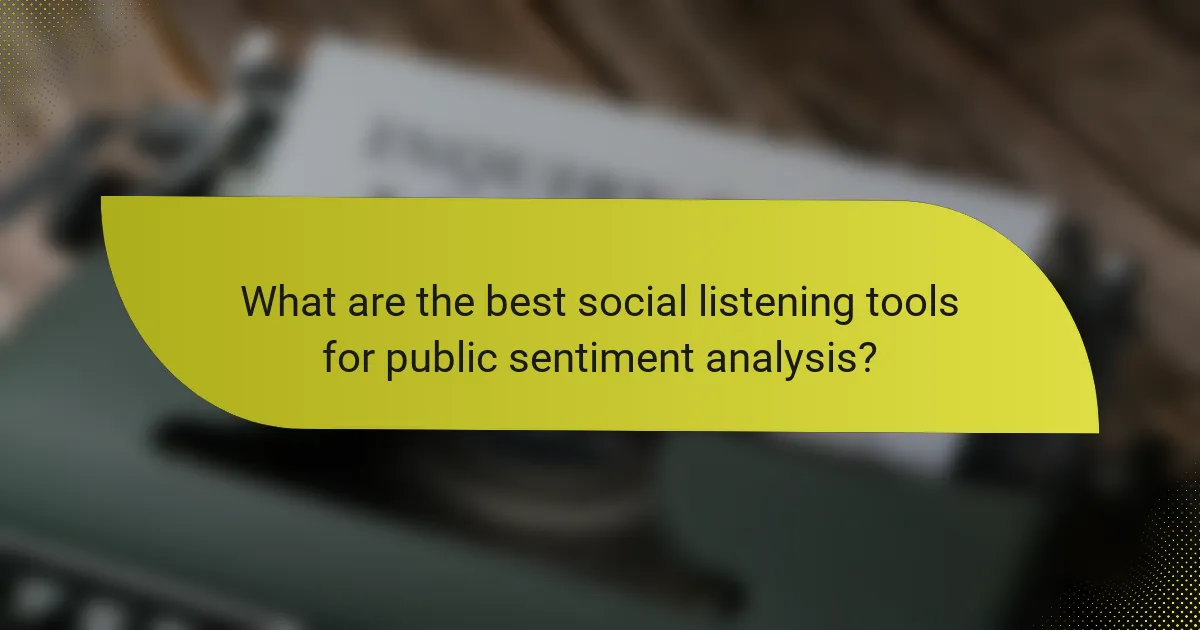Social listening tools are essential for analyzing public sentiment and tracking trends across various online platforms. By aggregating data from social media, blogs, and forums, these tools enable businesses to gain valuable insights into consumer behavior and emerging trends. Understanding public opinion through these analyses helps companies refine their strategies and enhance customer relations.

What are the best social listening tools for public sentiment analysis?
The best social listening tools for public sentiment analysis include platforms that aggregate and analyze data from social media, blogs, and forums to gauge public opinion. These tools help businesses understand consumer sentiment, track trends, and derive actionable insights from online conversations.
Brandwatch
Brandwatch is a powerful social listening tool that excels in tracking brand mentions and analyzing sentiment across various platforms. It uses advanced AI to provide insights into consumer behavior and preferences, allowing businesses to respond effectively to public sentiment.
With features like customizable dashboards and real-time alerts, Brandwatch enables users to monitor trends and engage with their audience promptly. It’s particularly useful for brands looking to enhance their reputation and tailor their marketing strategies based on public feedback.
Sprout Social
Sprout Social offers comprehensive social media management along with robust listening capabilities. It allows users to track brand mentions, analyze sentiment, and identify trends in customer conversations across social networks.
This tool is ideal for businesses that want to integrate social listening with their overall social media strategy. Its user-friendly interface and reporting features make it easy to visualize data and share insights with teams.
Hootsuite Insights
Hootsuite Insights provides users with the ability to monitor conversations and sentiment across multiple social media platforms. It aggregates data from various sources, enabling businesses to see how their brand is perceived online.
The tool is particularly beneficial for real-time monitoring, helping brands to quickly address negative sentiment or capitalize on positive trends. Its integration with Hootsuite’s social media management features allows for seamless engagement with audiences.
Talkwalker
Talkwalker is known for its extensive analytics capabilities, including image recognition and video analysis. It helps brands track sentiment and engagement across social media, blogs, and news sites, providing a holistic view of public opinion.
With its powerful analytics engine, Talkwalker can identify emerging trends and potential crises, making it a valuable tool for proactive brand management. Its customizable reports allow teams to focus on metrics that matter most to their objectives.
NetBase Quid
NetBase Quid specializes in deep social analytics, offering insights into consumer sentiment and market trends. Its AI-driven platform analyzes vast amounts of data to provide actionable insights for brands looking to enhance their market positioning.
This tool is particularly useful for understanding complex consumer behaviors and preferences, enabling brands to make data-driven decisions. Its ability to track sentiment across various demographics helps tailor marketing efforts effectively.

How do social listening tools track trends and insights?
Social listening tools track trends and insights by monitoring online conversations across various platforms, analyzing keywords, and assessing public sentiment. These tools help businesses understand consumer behavior, identify emerging trends, and gain a competitive edge.
Keyword tracking
Keyword tracking involves monitoring specific terms or phrases relevant to a brand or industry across social media and online platforms. By analyzing the frequency and context of these keywords, businesses can gauge public interest and engagement levels. For example, tracking a product name can reveal spikes in conversation during marketing campaigns or product launches.
Effective keyword tracking requires selecting a mix of broad and niche terms. Broad keywords may capture general trends, while niche keywords can provide deeper insights into specific audience segments. Regularly updating your keyword list is essential to stay aligned with evolving consumer interests.
Sentiment analysis
Sentiment analysis evaluates the emotions behind online conversations, categorizing them as positive, negative, or neutral. This analysis helps brands understand public perception and emotional responses to their products or services. For instance, a surge in negative sentiment during a product recall can prompt immediate action to address customer concerns.
Implementing sentiment analysis effectively involves using natural language processing (NLP) tools that can accurately interpret context and nuances in language. It’s important to consider cultural differences in sentiment expression, as phrases may carry different meanings across regions.
Competitor benchmarking
Competitor benchmarking compares a brand’s social media performance against that of its competitors. This process involves analyzing engagement metrics, sentiment scores, and keyword performance to identify strengths and weaknesses. For example, if a competitor receives significantly more positive sentiment, it may indicate areas for improvement in your own strategy.
To conduct effective benchmarking, select key performance indicators (KPIs) that align with your business goals. Regularly review competitor activity and adjust your strategies accordingly to maintain relevance in the market. Tools that automate this process can save time and provide more accurate insights.

What are the benefits of using social listening tools?
Social listening tools provide valuable insights into public sentiment, trends, and consumer behavior, enabling businesses to understand their audience better. By analyzing conversations across social media platforms, companies can enhance their strategies and improve customer relations.
Improved customer engagement
Utilizing social listening tools allows businesses to interact with customers in real-time, fostering a more engaging experience. By monitoring mentions and comments, companies can respond promptly to inquiries or concerns, which helps build trust and loyalty.
For example, a brand that quickly addresses customer complaints on social media can turn a negative experience into a positive one, enhancing overall satisfaction. Regularly analyzing engagement metrics can guide businesses on the best times and platforms to connect with their audience.
Data-driven decision making
Social listening tools empower organizations to make informed decisions based on actual consumer data rather than assumptions. By tracking trends and sentiments, businesses can identify emerging topics and adjust their strategies accordingly.
For instance, if a significant number of users express interest in sustainable products, a company can pivot its marketing efforts to highlight eco-friendly offerings. Regularly reviewing analytics can help refine campaigns and allocate resources effectively.
Brand reputation management
Monitoring social media conversations is crucial for maintaining a positive brand reputation. Social listening tools help identify potential issues before they escalate, allowing companies to address negative sentiment proactively.
For example, if a product is receiving unfavorable reviews, a brand can respond directly to customers and implement changes based on feedback. Establishing a system for regular reputation checks can help mitigate risks and reinforce a positive public image.

What criteria should you consider when selecting a social listening tool?
When selecting a social listening tool, consider factors such as integration capabilities, pricing models, and user interface. These criteria will help ensure the tool meets your specific needs and enhances your ability to analyze public sentiment, trends, and insights effectively.
Integration capabilities
Integration capabilities refer to how well the social listening tool can connect with other platforms and tools you use, such as CRM systems, marketing automation software, or analytics platforms. A tool that seamlessly integrates with your existing systems can streamline workflows and improve data accuracy.
Look for tools that offer APIs or built-in connectors for popular applications. This can save time and reduce manual data entry, allowing for more efficient analysis of social media conversations and trends.
Pricing models
Pricing models for social listening tools can vary widely, often including subscription-based plans, pay-as-you-go options, or tiered pricing based on features. Evaluate your budget and the specific features you need to ensure you choose a model that provides good value.
Many tools offer free trials or demo versions, allowing you to test their functionality before committing. Be cautious of hidden fees for additional features or data access, which can significantly increase costs over time.
User interface and experience
The user interface and experience of a social listening tool are crucial for effective usage. A clean, intuitive design can facilitate easier navigation and quicker insights, while a cluttered interface can lead to frustration and inefficiency.
Consider tools that offer customizable dashboards and visualizations to help you track metrics that matter most to your organization. User feedback and reviews can provide valuable insights into how other users perceive the usability of the tool.

How do social listening tools enhance marketing strategies?
Social listening tools significantly enhance marketing strategies by providing insights into public sentiment, trends, and consumer preferences. These tools analyze social media conversations and online mentions to help brands understand their audience better and tailor their marketing efforts accordingly.
Understanding Public Sentiment
Public sentiment refers to the overall attitude or emotional tone expressed by consumers towards a brand or product. Social listening tools track mentions across various platforms, allowing marketers to gauge how their audience feels in real-time. This understanding can guide campaigns, product development, and customer service improvements.
For example, if a brand notices a surge in negative sentiment following a product launch, they can quickly address the issues raised by consumers, potentially mitigating damage to their reputation. Regularly monitoring sentiment can lead to proactive strategies that align with audience expectations.
Identifying Trends
Identifying trends is crucial for staying relevant in a fast-paced market. Social listening tools can highlight emerging topics and shifts in consumer behavior by analyzing large volumes of data from social media and forums. Marketers can use this information to adapt their strategies and capitalize on new opportunities.
For instance, if a trend towards sustainable products emerges, brands can adjust their messaging or product offerings to resonate with this growing interest. Keeping an eye on trends helps businesses remain competitive and responsive to market demands.
Gaining Insights for Strategy Development
Insights gained from social listening can inform various aspects of marketing strategy, from content creation to audience targeting. By understanding what resonates with their audience, marketers can craft more effective campaigns that drive engagement and conversions. This data-driven approach reduces guesswork and enhances overall marketing effectiveness.
For example, if analytics show that a particular type of content generates high engagement, brands can focus on producing similar content to maintain interest. Additionally, insights into audience demographics and preferences can help refine targeting efforts, ensuring that marketing messages reach the right people.
